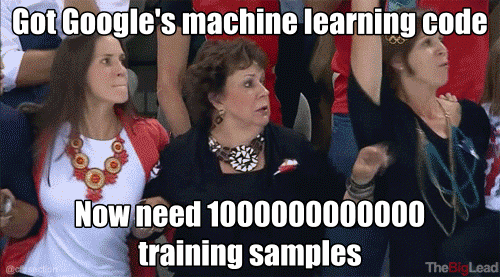How much training data do you need?
How much training data do you need?
//@樵夫上校: 0. 经验上,10X规则(训练数据是模型参数量的10倍)适用与大多数模型,包括shallow network. 1.线性模型可以应用10X的经验规则,模型参数是特征选择后的数量(PCA等方法)。2.NN可以将10X规则当做训练数据量的下限。

The quality and amount of training data is often the single most dominant factor that determines the performance of a model. Once you have the training data angle covered, the rest usually follows. But exactly how much training data do you need? The correct answer is: it depends. It depends on the task you are trying to perform, the performance you want to achieve, the input features you have, the noise in the training data, the noise in your extracted features, the complexity of your model and so on. So the way to find out the interaction of all these variables is to train your model on varying amounts of training data and plot learning curves. But this requires you to already have some decent amount of training data to construct interesting plots. What do you do when you are just starting out? Or when you suspect you have too little training data and want to estimate how big a problem you are in?
So instead of the dead accurate “correct” answer to the problem, how about an estimate, a practical rule of thumb? One way out is to take an empirical approach as follows. First, automatically generate a lot of logistic regression problems. For each generated problem, study the relationship between the amount of training data and the performance of the trained models. Observing this relationship over a range of problems, generalize to a simple rule.

Here is the code to generate a range of logistic regression problems and study the effect of varying the amount of training data. The code is based onTensorflow. Running the code doesn’t require any special software or hardware (Tensorflow is open sourced by Google), and I was able to run the entire experiment on my laptop. Upon running, the code spits out the graph below.

The x-axis is the ratio of the number of training samples to the number of model parameters. The y-axis is the f-score of the trained model. The curves in different colors correspond to models that differ in the number of parameters. For example, the red curve which corresponds to a model with 128 parameters indicate how the fscore changes as one varies the number of training samples to 128 x 1, 128 x 2 and so on.
The first observation is that the f-score curves don’t vary as the parameters scale. This is expected given the models are linear and it’s good to see that some hidden non-linearity doesn’t creep in. Of course, larger models need more training data, but for a given ratio of the number of training samples to the number of model parameters you get the same peformance. The second observation is that when the ratio of training samples to model parameters is 10:1, the f-score lands in the vicinity of 0.85 which we take as the definition of a well performing model. This leads us to the rule of 10, namely the amount of training data you need for a well performing model is 10x the number of parameters in the model.
The rule of 10 transforms the problem of estimating the amount of training data required to knowing the number of parameters in the model, so it deserves some discussion. For linear models such as logistic regression, the number of parameters equal the number of input features since the model assigns a parameter corresponding to each feature. However there could be some complications:
- Your features may be sparse, so counting the number of features may not be straightforward.
- Due to regularization and feature selection techniques a lot of features may be discarded, so the real feature count is much smaller than the number of raw features that are input to the model.
One way to tackle the issue is to observe that you don’t really need labeled data to get an estimate of the number of features, even unlabeled examples are sufficient for that purpose. For example, given a large corpus of text, you can generate histograms of word frequencies to understand your feature space before beginning to label the data for training. Given the histogram, you can discard the words in the long tail to get an estimate of the real feature count, which then gives an estimate of the amount of training data you need applying the rule of 10.
Neural networks pose a different set of problems than linear models like logistic regression. To get the number of parameters in a neural network you need to
- Count the number of parameters used in the embedding layer if your input is sparse (see the Tensorflow tutorial on word embeddings for example).
- Count the number of edges in your network.
The problem is the relationship between the parameters in a neural network is no longer linear, so the emperical study we did based on logistic regression doesn’t really apply anymore. In such cases you can treat the rule of 10 as a lower bound to the amount of training data needed.
Despite the complications above, in my experience the rule of 10 seem to work across a wide range of problems, including shallow neural nets. However when in doubt, plug in your own model and assumptions in the Tensorflow code and run the simulation to study it’s effects. Please feel free to share if you gain any insight in the process.

How much training data do you need?的更多相关文章
- 阅读笔记 The Impact of Imbalanced Training Data for Convolutional Neural Networks [DegreeProject2015] 数据分析型
The Impact of Imbalanced Training Data for Convolutional Neural Networks Paulina Hensman and David M ...
- 什么情况下使用large training data会非常有效
收集大量的数据可能比算法的优劣更重要 Banko和Brill在2001年做了一个研究,是关于在句子中对易混单词进行识别,画出了上图的右边的那个图,这个图显示了对于不同的算法,它们的表现相似,但是随着t ...
- 论文解读(SR-GNN)《Shift-Robust GNNs: Overcoming the Limitations of Localized Graph Training Data》
论文信息 论文标题:Shift-Robust GNNs: Overcoming the Limitations of Localized Graph Training Data论文作者:Qi Zhu, ...
- [Tensorflow] Object Detection API - prepare your training data
From: TensorFlow Object Detection API This chapter help you to train your own model to identify obje ...
- 16 On Large-Batch Training for Deep Learning: Generalization Gap and Sharp Minima 1609.04836v1
Nitish Shirish Keskar, Dheevatsa Mudigere, Jorge Nocedal, Mikhail Smelyanskiy, Ping Tak Peter Tang N ...
- Data Transformation / Learning with Counts
机器学习中离散特征的处理方法 Updated: August 25, 2016 Learning with counts is an efficient way to create a compact ...
- 一天一经典Reducing the Dimensionality of Data with Neural Networks [Science2006]
别看本文没有几页纸,本着把经典的文多读几遍的想法,把它彩印出来看,没想到效果很好,比在屏幕上看着舒服.若用蓝色的笔圈出重点,这篇文章中几乎要全蓝.字字珠玑. Reducing the Dimensio ...
- Deep Learning in a Nutshell: History and Training
Deep Learning in a Nutshell: History and Training This series of blog posts aims to provide an intui ...
- Deep Learning 16:用自编码器对数据进行降维_读论文“Reducing the Dimensionality of Data with Neural Networks”的笔记
前言 论文“Reducing the Dimensionality of Data with Neural Networks”是深度学习鼻祖hinton于2006年发表于<SCIENCE > ...
随机推荐
- 静态时序分析(static timing analysis) --- 时序路径
时序分析工具会找到且分析设计中的所有路径.每一个路径有一个起点(startpoint)和一个终点(endpoint).起点是设计中数据被时钟沿载入的那个时间点,而终点则是数据通过了组合逻辑被另一个时间 ...
- 不支持一个 STA 线程上针对多个句柄的 WaitAll
[csharp] view plaincopy using System; using System.Collections.Generic; using System.Windows.Forms; ...
- opencv中的图像复制、保存和显示
接下来几天会写一个opencv的基础系列,与各位相互学习! &1 图像操作 声明图像指针:IplImage* 读入图像: cvLoadImage 创建图像:cvCreateImage 复制图像 ...
- [MetaHook] Quake OpenGL function
Quake OpenGL function for MetaHook plugin. Thank hzqst :D QGL.h #ifndef QGL_H #define QGL_H #include ...
- 20145222黄亚奇《Java程序设计》第7周学习总结
教材学习内容总结 第十三章 时间与日期 即使标注为GMT(格林威治时间),实际上谈到的的是UTC(Unix时间)时间. 秒的单位定义时基于TAI.也就是铯原子辐射的振动次数. Unix时间是1970年 ...
- 2.SQLAlchemy文档-SQLAlchemy ORM(中文版)
接下来,我们将会对对象关系映射器进行全面的介绍和描述.如果你想用它为你的应用程序构建更高层次的SQL操作模式,以及为你的Python对象提供自动化的持久性功能,那么首先进行下列教程的学习吧. 首先请看 ...
- 我的权限系统设计实现MVC4 + WebAPI + EasyUI + Knockout(二)菜单导航
一.前言 上篇博客中已经总体的说了一下权限系统的思路和表结构设计,那接下来我们就要进入正文了,先从菜单导航这个功能开始. 二.实现 这个页面基本不用什么需求分析了,大家都很明白,不过在这个页面要多维护 ...
- Python3常用内置函数
数学相关 abs(a) : 求取绝对值.abs(-1) max(list) : 求取list最大值.max([1,2,3]) min(list) : 求取list最小值.min([1,2,3]) su ...
- unity3d NGUI制作角色展示框
最近在搞赛车漂移,所以一直没有更新博客 现在已经实现圈数检测.复位点检测.反向检测等功能 本来准备写成三篇文章的,太忙了,等过段时间不忙了在写吧 今天有朋友问我3D角色怎么给他固定在一个框里面 这个功 ...
- PM2实用入门指南
简介 PM2是node进程管理工具,可以利用它来简化很多node应用管理的繁琐任务,如性能监控.自动重启.负载均衡等,而且使用非常简单. 下面就对PM2进行入门性的介绍,基本涵盖了PM2的常用的功能和 ...
